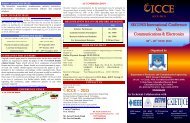Download PDF - Krishna Institute of Engineering and Technology
Download PDF - Krishna Institute of Engineering and Technology
Download PDF - Krishna Institute of Engineering and Technology
You also want an ePaper? Increase the reach of your titles
YUMPU automatically turns print PDFs into web optimized ePapers that Google loves.
International KIET Journal <strong>of</strong> S<strong>of</strong>tware <strong>and</strong> Communication Technologies (IKJSCT)Volume 1, Issue 1, pp: 7-15, April 20133.5.4 GOMS; John <strong>and</strong> Kieras model [24]The Goals, Operators, Methods, <strong>and</strong> Selection rules(GOMS) model was designed for a specific taskwhich contains the methods to achieve the desiredgoals with the help <strong>of</strong> a s<strong>of</strong>tware system. Thesemethods are considered as a series <strong>of</strong> operationsthat must be executed by the user while working onthat system. Furthermore goals can also be calledby a method to perform a task. Hence this modelhas a hierarchical structure. This model is used topredict the user performance in task analysis phase.Here user performance can be measured in tern <strong>of</strong>time taken by user to perform the task. But thismodel lacks in verifying these predictions.3.5.5 NIST; Scholtz <strong>and</strong> Laskowski model [25]The National <strong>Institute</strong> <strong>of</strong> St<strong>and</strong>ards <strong>and</strong><strong>Technology</strong> (NIST) Web Metrics provide s a set <strong>of</strong>six computer tools <strong>and</strong> different metrics whichprovide the support for remote, rapid <strong>and</strong>automated testing <strong>and</strong> evaluation <strong>of</strong> web Usability.3.5.6 Quality in use integrated measurement(QUIM) [22]This model agglomerates various factors <strong>and</strong>measures all together. This model also defines therelationship among these factors, criteria <strong>and</strong>metrics which are used to evaluate the Usability.This model defines the Usability with the help <strong>of</strong>ten factors. These factors are efficiency,effectiveness, safety, satisfaction, learnability,truthfulness, accessibility, usefulness, universality<strong>and</strong> productivity. These all factors in this model areconsidered to be dependent <strong>and</strong> give the consistentdefinitions <strong>of</strong> these models. This model alsoprovides the QUIM editor which provides the toolsupport up to some extant for measuring theUsability to both expert users as well as to the userwhich are not familiar with Usability engineering.This model tried to provide a broader theory <strong>of</strong>Usability measurement but it lacks in evaluatingthe Usability more empirically.3.5.7 Mohd. Haleem et al [26]This paper recognizes the Usability as the ―qualityin use‖. Here authors provide a new quality model12 | P a g ewhich is used to quantify the Usability matrices.This new proposed model is considered asframework to quantify <strong>and</strong> specify the quality inuse components. This model includes various types<strong>of</strong> factors, criteria, matrices <strong>and</strong> also datacharacterized in different Human ComputerInterface <strong>and</strong> S<strong>of</strong>tware <strong>Engineering</strong>. It is ahierarchical model which can be viewed as thecombinations <strong>of</strong> other existing models. It differsfrom others in the way <strong>of</strong> decomposition <strong>of</strong> level <strong>of</strong>Usability such as factors, criteria <strong>and</strong> metrics. Thismodel has Usability criteria in this model areeffectiveness, efficiency, satisfaction,internationability, Accessibility, Productivity,Safety, Learnability, Trustfulness, Universality,Adjustability, Portability, <strong>and</strong> Modifiability. Thismodel can be supportive for creations <strong>of</strong> Usabilitymeasurements plans only in the conditions wherespecific metrics are identified <strong>and</strong> defined certainhigher level goals <strong>of</strong> Usability such as satisfaction,learnability, <strong>and</strong> efficiency. It can be extended tosupport other broad field <strong>of</strong> engineering.3.5.8 Piyush Jain et al [27]Here authors have tried to evaluate the Usability <strong>of</strong>s<strong>of</strong>tware through the use <strong>of</strong> fuzzy logic technique.Here Usability is defined as the factor <strong>of</strong> s<strong>of</strong>twarequality model which deals with the userrequirements. Authors also tried to include theUsability engineering phase in the SDLC (S<strong>of</strong>twareDevelopment Life Cycle) model to enhance thes<strong>of</strong>tware performance. This paper has given thedescription <strong>of</strong> some Usability estimation methods<strong>and</strong> proposed a technique called fuzzy logic systemfor evaluating the s<strong>of</strong>tware Usability. Thistechnique is more useful than other techniquesdescribed because this deals with the uncertainty.This technique can be used where conditions arenot constant <strong>and</strong> varies according to the time. Asuser requirements are also not constant <strong>and</strong> changesaccordingly so this technique is used. But for moreaccurate estimation <strong>of</strong> Usability we can use herethe combination <strong>of</strong> two techniques named as neuralnetwork <strong>and</strong> fuzzy system. This technique is calledneuro-fuzzy approach. This is more effectivebecause it combines the benefits <strong>of</strong> both thetechniques.




